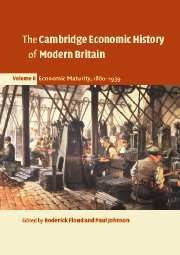Book contents
- Frontmatter
- 1 Long-run growth
- 2 Population and regional development
- 3 Human capital and skills
- 4 Manufacturing and technological change
- 5 The service sector
- 6 Agriculture, 1860–1914
- 7 Trade, 1870–1939: from globalisation to fragmentation
- 8 Foreign investment, accumulation and Empire, 1860–1914
- 9 Enterprise and management
- 10 Domestic finance, 1860–1914
- 11 Living standards, 1860–1939
- 12 The British economy between the wars
- 13 Unemployment and the labour market, 1870–1939
- 14 British industry in the interwar years
- 15 Industrial and commercial finance in the interwar years
- 16 Scotland, 1860–1939: growth and poverty
- 17 Government and the economy, 1860–1939
- References
- Index
5 - The service sector
Published online by Cambridge University Press: 28 March 2008
- Frontmatter
- 1 Long-run growth
- 2 Population and regional development
- 3 Human capital and skills
- 4 Manufacturing and technological change
- 5 The service sector
- 6 Agriculture, 1860–1914
- 7 Trade, 1870–1939: from globalisation to fragmentation
- 8 Foreign investment, accumulation and Empire, 1860–1914
- 9 Enterprise and management
- 10 Domestic finance, 1860–1914
- 11 Living standards, 1860–1939
- 12 The British economy between the wars
- 13 Unemployment and the labour market, 1870–1939
- 14 British industry in the interwar years
- 15 Industrial and commercial finance in the interwar years
- 16 Scotland, 1860–1939: growth and poverty
- 17 Government and the economy, 1860–1939
- References
- Index
Summary
The importance of services to the achievements of the industrial revolution is gradually becoming realised. Britain may have been by 1851 the ‘workshop of the world’, but it was also the pioneer service economy, with over 30 per cent of its labour force already devoted to the provision of services to domestic and overseas markets, contributing almost half of national income. Services further increased in statistical significance after 1850: by 1939, half the labour force was employed in the tertiary sector. It seems right to argue that services played an important role in the maturing of modern Britain. Yet it may also be right to argue that they played a role in slowing down British economic growth and contributing to the catch-up by other economies.
THE TERTIARY SECTOR
The boundaries of the service sector are famously imprecise, its content notoriously heterogeneous. Fisher (1952), who coined the term, ‘tertiary sector’, to distinguish services from primary (agriculture, mining) and secondary (manufacturing, construction) activities, noted that it was defined not from any positive attributes, but rather as a residual claimant, ‘a miscellaneous rag-bag into which everything has to be thrown that cannot conveniently be fitted anywhere else’. The heterogeneity is reflected in Adam Smith’s famous compilation, ‘some both of the gravest and most important, and some of the most frivolous professions: churchmen, lawyers, physicians, men of letters of all kinds; players, buffoons, musicians, opera singers, opera dancers, etc.’ (Smith 1976 [1776]: 331).
- Type
- Chapter
- Information
- The Cambridge Economic History of Modern Britain , pp. 99 - 132Publisher: Cambridge University PressPrint publication year: 2004
- 3
- Cited by

